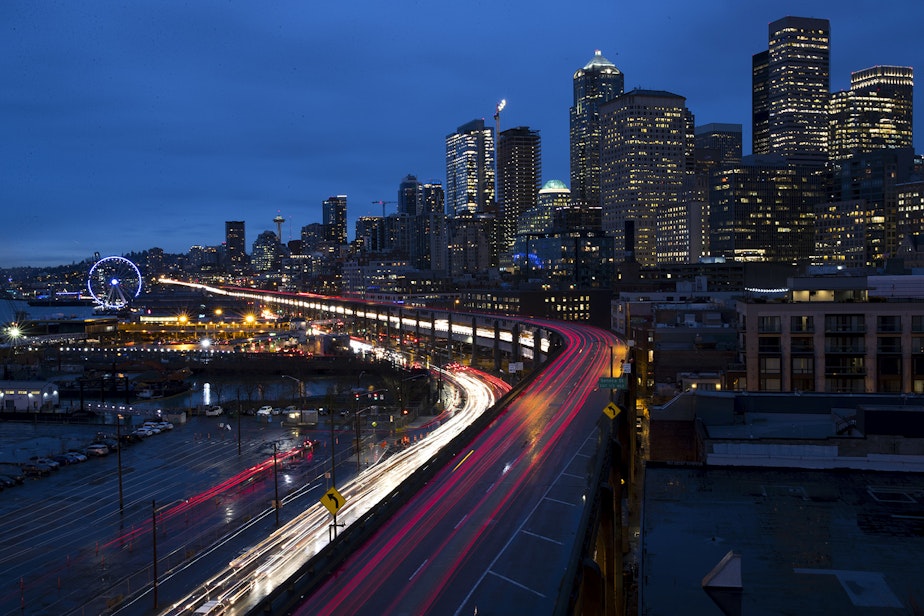Requiem for a viaduct

It was like a bad boyfriend.
Loud. Dirty. Unstable.
But when you were together, it felt like flying into the sunset. In fact, you kinda were flying into the sunset.
Yes, the whole thing might fall apart in an instant — that's all anyone ever told you — but those views! Oh my heaven, those views!
And that skyline. Did anyone else notice that it was made of three half circles — the ferris wheel and the two stadiums? Was that on purpose? Because if so, genius.
Those cranes, huge and looming, red and yellow, like giant mechanical dinosaurs ... and the silvery sheen on Elliott Bay ... and the cruise ships we hated but from here, on the top deck, had a touch of charm.
But it's over now. 10 p.m. tonight, Friday, kaput. Closed.
Sponsored
For 65 years, millions flew this elevated freeway — life is a highway, truly — to skip the one-way purgatory blech of downtown Seattle.
Ugly, shrinking, not just a little terrifying: but it will be missed. Even the mayor is sad to see the end.
“There are those of us, myself included who have a little bit of love for the viaduct,” Jenny Durkan told reporters last week.
But also a little bit of fear: “When I drive on the Viaduct I try to go as fast as I can since the earthquake,” she said.
The viaduct, née Alaskan Way Viaduct, came into this world in 1953. It was after the war, a time of optimism, when everyone was getting a car.
Sponsored
At the time, streets were the only way to get through downtown Seattle. A double-decker freeway placed right over busy old Railroad Avenue seemed a smart and fashionable move. Other cities were getting them. They looked efficient and modern. (They were younger then.)
But the viaduct was going to kill somebody someday if we didn’t stop it. We got our first clue about this when the Cypress Street Viaduct in Oakland crushed 42 people during the 1989 Loma Prieta earthquake.
Yes, 1989. Thirty years ago. Breaking up is hard to do, after all.
It became a cracked and sinking hulk in 2001 when faced with the magnitude 6.8 Nisqually earthquake. It was time then to say goodbye.
Peter Steinbrueck was a Seattle city councilmember when the decision was made to replace the Viaduct with a deep-bore tunnel.
Sponsored
He said people who want to hold onto it for an elevated park, to just be friends, or something, must let go.
“It sits in a liquefaction zone right over the Seattle fault with joints and connections that can be broken like toothpicks in an earthquake," Steinbrueck said. "With enormous disastrous potential."
It’s been harder to let go of the Viaduct than we thought it would be, even though we're trading it in for a younger, more stable, more attractive model. (Also more expensive, oof: $3.3 billion at last count.)
The hardest part was getting the tunnel borer to do its job. Instead of taking 14 months, the job took 45 months including the multi-year rescue and repair of the machine.
And despite the earthquake hazard, we just kept driving on it. Steinbrueck said there wasn’t the political will to shut it down.
Sponsored
“The governors at the time certainly were not willing,” he said. “What great risk was posed by the potential collapse was not enough to shut it down.”
The Alaskan Way Viaduct is one of only three major north-south corridors, to be fair. Politicians and planners couldn’t take the risk of gridlock from just condemning the thing. There is, of course, another reason why we hung onto the viaduct.
Those views! Even Steinbrueck couldn't get enough. “Stupendous,” he called them.
“I know a lot of people will miss that extraordinary experience of driving on the viaduct and the stupendous views on a sunny day with the mountains and glistening water,” he said.
(Did we forget to mention the mountains? We did. Breathtaking.)
Sponsored
But when the viaduct comes down this year, this will be a view that everyone will be able to see, because they’ll be able to get right down to the waterfront. And they’ll be able to explore a new park that celebrates the city and Puget Sound. Maybe we’ll still get to experience what Katy Tomasulo used to see at sundown: “The view to the left is just spectacular but to the right, the buildings are pinkish and twinkling.”
A celebration of the viaduct’s life is being held by the state transportation department over several days starting February 2.
Kiewit Infrastructure West is entrusted with demolition. Burial to be carried out in the Battery Street Tunnel.
Adieu, viaduct. We've come to the end of the road.
Whatever your relationship with the viaduct, KUOW invites you to bid farewell to this elevated structure in style. Join us for an open mic-style event where we bid goodbye to the viaduct with music, poetry, limericks…etc. Doors open: 6:30 PM
Show begins: 7:00 PM Cafe Nordo (The Knife Room)
103 S Main St
Seattle, WA 98104



